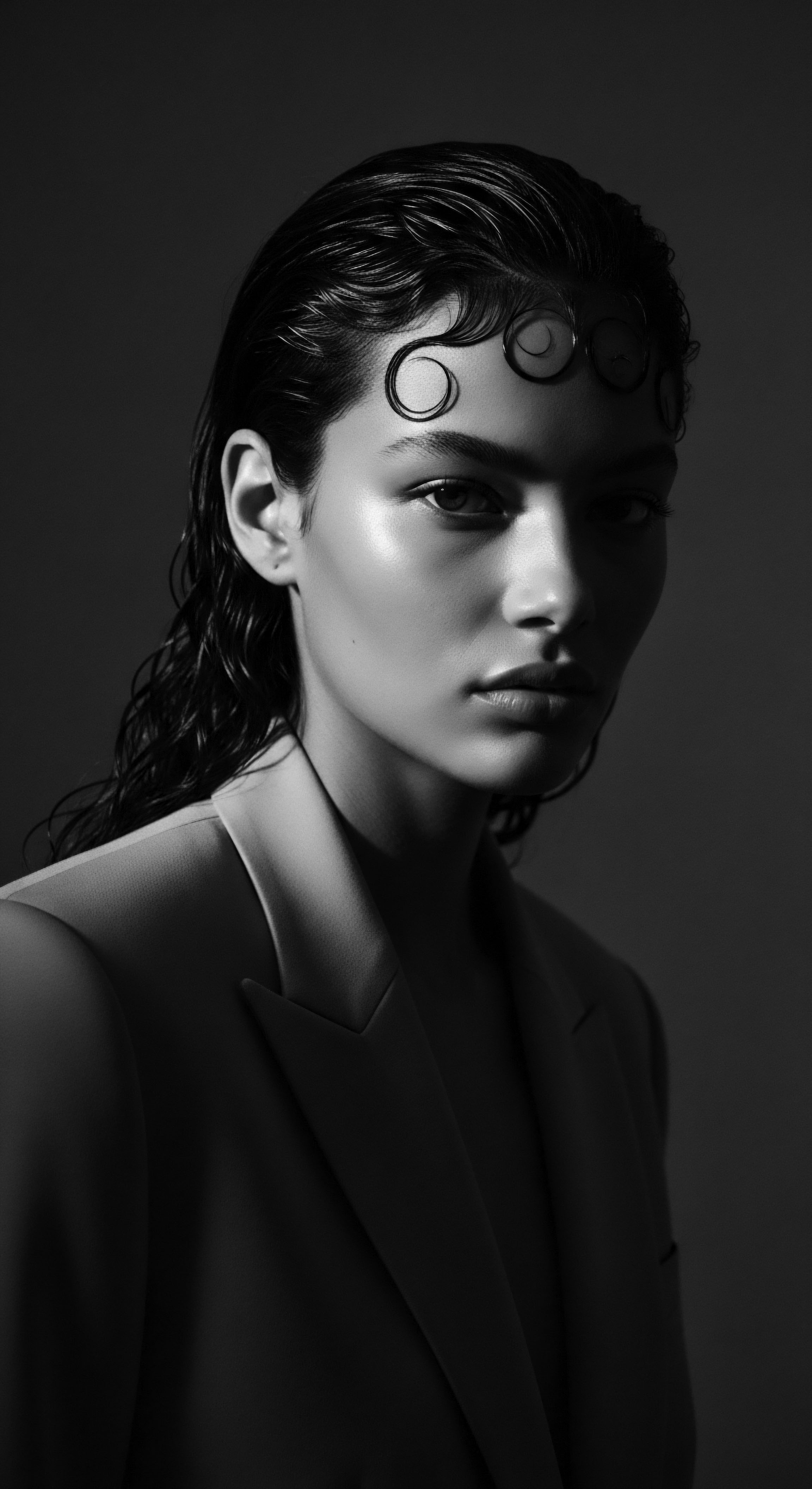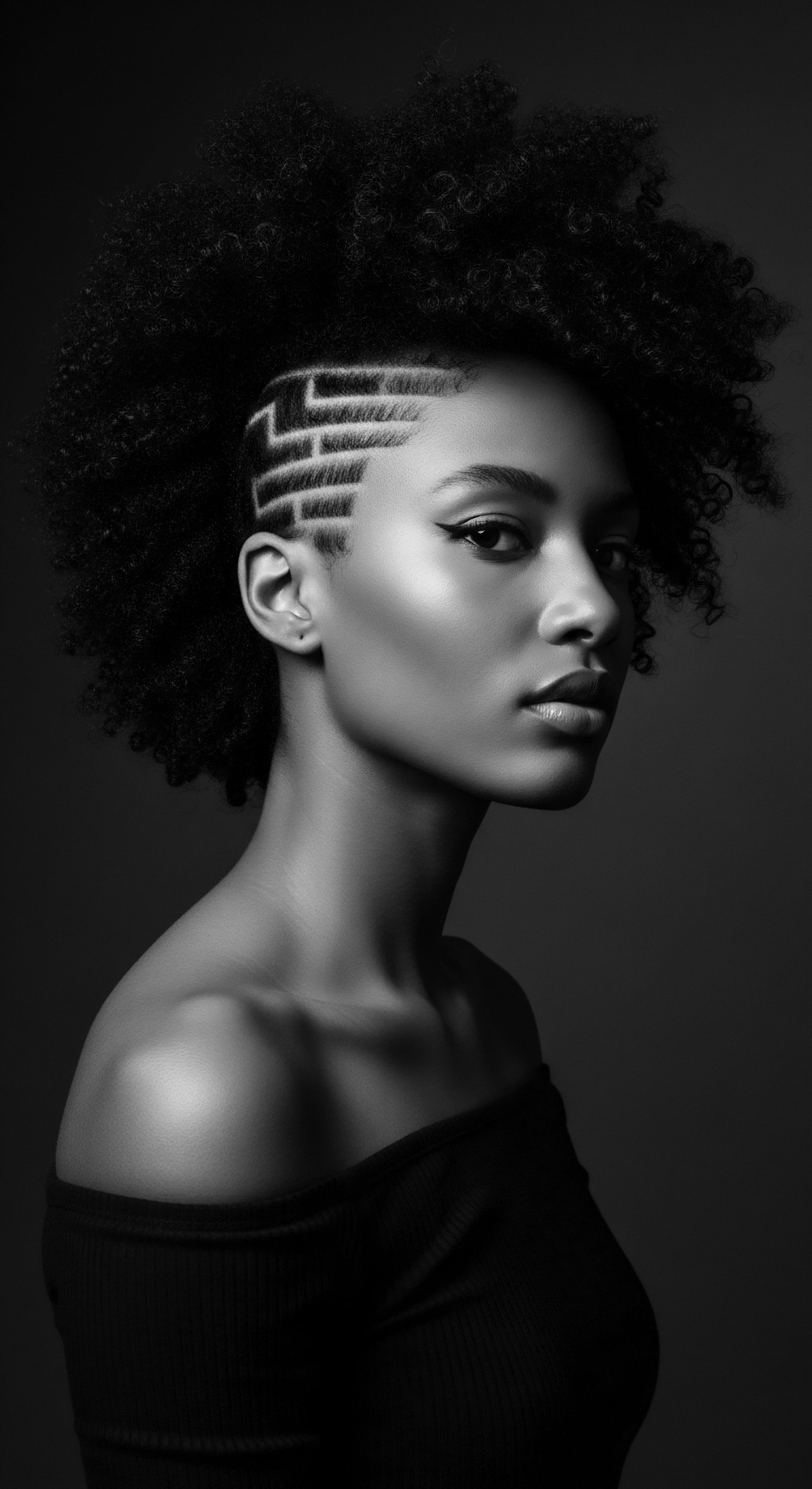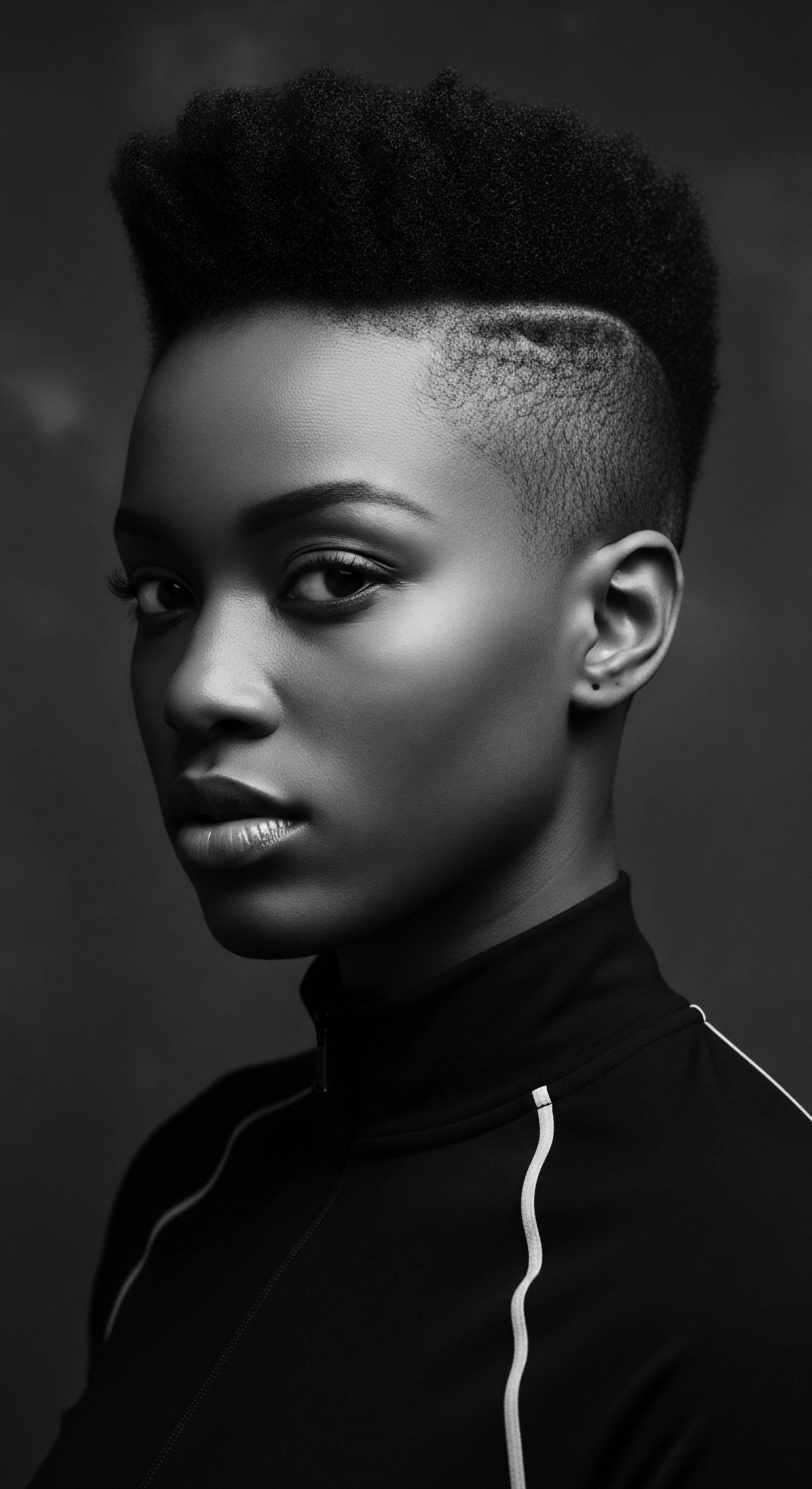
Fundamentals
The Textured Hair Movements represent a powerful, multi-generational journey of self-discovery and collective affirmation. At its most fundamental level, this concept describes the profound cultural and social shifts that have unfolded around naturally coiling, kinky, and wavy hair textures, particularly within Black and mixed-race communities. It is not merely a trend or a passing style; rather, it signifies a deep, ongoing re-evaluation of beauty standards, identity, and ancestral connection. The movements acknowledge the inherent beauty and versatility of hair that grows from the scalp in its natural, unadulterated form, rejecting historical pressures to conform to Eurocentric ideals.
For many, understanding Textured Hair Movements begins with recognizing the simple, yet often suppressed, truth ❉ hair in its natural state is worthy of reverence and care. This initial realization acts as a gentle invitation to explore a heritage that has long been obscured by dominant beauty narratives. It is about recognizing the inherent worth of each strand, each curl, each coil, as a living testament to resilience and unique genetic expression.
The Textured Hair Movements are a reclamation of ancestral beauty and a profound affirmation of self, beginning with the simple acceptance of natural hair.

The Roots of Reclaiming Identity
The genesis of these movements lies in a historical longing for authentic self-expression. Centuries of imposed beauty norms often dictated that straight hair was the sole marker of acceptability or professionalism. This led to widespread practices designed to alter natural texture, sometimes with harsh and damaging consequences. The Textured Hair Movements emerged as a collective response, a conscious turning back towards inherent hair patterns and the rich traditions of care that accompanied them in pre-colonial African societies.
A fundamental aspect of this understanding involves acknowledging the historical context. Before the transatlantic slave trade, hair in various African societies conveyed intricate messages. It signaled a person’s marital status, age, religious affiliation, ethnic identity, wealth, and position within the community. Hair was a visual language, a living chronicle of one’s place in the world.
(Byrd & Tharps, 2001; Jacobs-Huey, 2006; Mercer, 1994; Patton, 2006; Rooks, 1996). The deliberate shaving of heads during enslavement was a brutal act of dehumanization, designed to strip individuals of their cultural markers and identity. Reclaiming textured hair today, therefore, carries the weight of this heritage, serving as an act of remembrance and cultural continuity.

Early Stirrings of Self-Acceptance
The initial phases of the Textured Hair Movements were often quiet, individual acts of defiance, preceding any widespread social recognition. These were personal decisions to forego chemical straighteners or hot tools, driven by a nascent desire for hair health or a growing discomfort with imposed standards. Over time, these individual choices began to coalesce, creating a shared understanding that natural hair was not something to be tamed or hidden, but rather celebrated.
- Hair as Identity ❉ In many African cultures, hair was a powerful symbol of identity and social standing.
- Ancestral Care ❉ Traditional hair care practices often involved natural ingredients like oils and herbs, focusing on nourishment and protection.
- Rejection of Imposed Norms ❉ The movements represent a conscious turning away from beauty standards that did not honor the natural growth patterns of textured hair.

Intermediate
Moving beyond the foundational understanding, the intermediate interpretation of Textured Hair Movements reveals a dynamic interplay of cultural expression, social activism, and personal liberation. This level of understanding acknowledges that these movements are not monolithic; they encompass a spectrum of experiences and motivations, all rooted in the shared heritage of textured hair. It signifies a collective awakening, where individuals actively seek to dismantle the systemic pressures that have historically marginalized natural hair.
The meaning of Textured Hair Movements expands here to encompass the deliberate re-education and re-connection with ancestral wisdom. It is a process of learning the unique needs of textured hair, understanding its biological structure, and appreciating the diverse ways it can be styled and adorned, drawing inspiration from ancient practices. This understanding empowers individuals to make informed choices about their hair care, moving beyond mere aesthetics to a deeper appreciation of well-being and cultural legacy.
The intermediate understanding of Textured Hair Movements reveals a collective journey of cultural re-education, social advocacy, and personal liberation, deeply connected to ancestral hair wisdom.

The Cultural Resurgence and Its Echoes
The mid-20th century marked a significant period in the Textured Hair Movements, particularly within the Black diaspora. The Civil Rights Movement and the Black Power Movement served as catalysts, transforming personal hair choices into potent political statements. The Afro hairstyle, in particular, became a powerful emblem of Black pride, self-acceptance, and resistance against Eurocentric beauty norms.
This era saw individuals like Angela Davis and the Black Panther Party popularizing the Afro as a symbol of solidarity and a rejection of assimilationist pressures. This period represents a clear delineation of the movements’ cultural and political dimensions, underscoring hair as a visible marker of identity and protest.
The cultural significance of hair extends beyond political statements; it permeates daily life and community bonds. In many African and diasporic communities, hair care has always been a communal activity, a time for storytelling, bonding, and the transmission of generational knowledge. The tender act of braiding a child’s hair, or applying nourishing butters, carries with it a legacy of care and connection that spans centuries. This communal aspect is a vital component of the Textured Hair Movements, reinforcing the idea that hair is not an isolated physical attribute, but a thread connecting individuals to their lineage and community.

Navigating Societal Perceptions
Even as the movements gained momentum, societal perceptions remained a significant hurdle. Natural hair was often deemed “unprofessional,” “messy,” or “unruly” in workplaces and educational settings. This discriminatory landscape pressured many Black individuals to chemically straighten their hair to avoid prejudice, a process that could be both physically and psychologically taxing. The intermediate phase of the movements grapples with these ongoing challenges, advocating for legislative changes like the CROWN Act, which seeks to protect natural hair from discrimination in various settings.
The conversation also extends to the subtle yet persistent forms of texturism, where looser curl patterns are sometimes favored over tighter coils, even within the natural hair community itself. An intermediate understanding acknowledges these internal dynamics, recognizing that the journey towards complete hair liberation involves confronting both external biases and internalized preferences. It is a continuous process of learning, unlearning, and broadening the scope of what is considered beautiful and acceptable within the vast spectrum of textured hair.
- The Afro’s Ascent ❉ The 1960s and 1970s witnessed the Afro becoming a symbol of Black pride and a rejection of Eurocentric beauty standards.
- Communal Care Rituals ❉ Hair care practices, traditionally shared among family and community, reinforced bonds and transmitted ancestral wisdom.
- Confronting Discrimination ❉ The movements actively address hair discrimination in professional and academic environments, seeking legal protections for natural styles.
- Understanding Texturism ❉ Acknowledging the internal biases within the natural hair community, where certain curl patterns might be privileged over others.
| Historical Period Pre-Colonial Africa |
| Dominant Hair Practice/Perception Elaborate braids, adornments, natural hair celebrated for status, age, and tribal identity. |
| Connection to Heritage/Identity Direct reflection of social standing, spiritual connection, and community belonging. |
| Historical Period Slavery Era |
| Dominant Hair Practice/Perception Forced shaving, concealment, adoption of simpler, hidden styles. |
| Connection to Heritage/Identity Loss of cultural markers, resilience through hidden practices, survival of traditions. |
| Historical Period Early 20th Century |
| Dominant Hair Practice/Perception Prevalence of hot combs and chemical relaxers for straightened hair. |
| Connection to Heritage/Identity Aspirations for assimilation, economic advancement, and perceived social acceptance. |
| Historical Period 1960s-1970s (Black Power) |
| Dominant Hair Practice/Perception Rise of the Afro, braids, locs as symbols of pride and protest. |
| Connection to Heritage/Identity Reclamation of African identity, political statement, rejection of Eurocentric norms. |
| Historical Period This historical trajectory underscores the enduring struggle and triumph of textured hair as a profound aspect of cultural heritage. |

Academic
The Textured Hair Movements, from an academic perspective, represent a complex socio-cultural phenomenon, a profound re-inscription of identity, and a decolonial project that challenges hegemonic beauty paradigms. This understanding extends beyond mere stylistic preference, delving into the intricate web of historical subjugation, psychological resilience, and economic self-determination that characterizes the journey of Black and mixed-race individuals reclaiming their natural hair. It is an intellectual and lived exploration of how hair, as a biological and cultural artifact, becomes a site of resistance, a canvas for self-definition, and a conduit for ancestral memory.
The meaning of Textured Hair Movements at this academic echelon is an elucidation of their systemic impact. It is a critical examination of how these collective shifts dismantle deeply ingrained stereotypes, re-evaluate scientific understandings of hair biology, and redefine wellness through a lens of ancestral practices. This analysis necessitates a multi-disciplinary approach, drawing from anthropology, sociology, psychology, and even ethnobotany, to comprehend the full scope of its implications for human experience and cultural continuity.
Academically, Textured Hair Movements signify a decolonial project, intricately linking hair to identity, resistance, and ancestral memory, necessitating a multi-disciplinary critical examination.

The Socio-Cultural Helix ❉ Hair as a Decolonial Act
The Textured Hair Movements stand as a powerful counter-narrative to centuries of colonial and post-colonial beauty standards that systematically devalued Afro-textured hair. Historically, European colonizers imposed their aesthetic norms, deeming natural Black hair as “uncivilized” or “unprofessional,” thereby creating a pervasive internalized racism that affected self-perception within diasporic communities. This academic lens scrutinizes how the movements actively dismantle this legacy of cultural violence. It is a deliberate act of decolonization, wherein individuals and communities re-assert their inherent aesthetic sovereignty.
The very act of choosing to wear one’s hair in its natural state, after generations of chemical alteration and social pressure, represents a conscious severance from a past dictated by external validation. Ingrid Banks’s ethnographic research in “Hair Matters ❉ Beauty, Power, and Black Women’s Consciousness” (2000) provides substantive insight into this phenomenon. Drawing on interviews with over 50 Black women, Banks reveals how discussions about hair serve as a profound avenue for expressing ideas about race, gender, sexuality, beauty, and power.
Her work demonstrates that for these women, hair is not a superficial concern, but a deeply embedded component of their self-identity and a site where they navigate and resist racial and gendered oppression. The decision to wear natural hair is frequently perceived as a strategy of resistance to white beauty standards and a re-connection to African roots and heritage (King & Niabaly, 2013).

Reclaiming the Crown ❉ A Psychological Perspective
The psychological impact of the Textured Hair Movements is particularly compelling. Generations of messaging, both overt and subtle, have contributed to “hair depression” and negative self-image among Black individuals who felt compelled to alter their natural hair for acceptance. Clinical psychologist Dr.
Afiya Mbilishaka, who pioneered “PsychoHairapy,” highlights how hair choices are inextricably linked to mental well-being and self-esteem. Her work underscores that the pressure to conform, often driven by workplace or school discrimination, leads to chronic stress, anxiety, and a diminished sense of belonging.
The act of embracing natural hair can be a profound pathway to psychological liberation. Studies indicate that authentic living correlates with higher self-esteem and overall well-being. For Black women, in particular, this journey often involves a re-evaluation of self-worth and a conscious decision to celebrate their unique beauty, moving away from the internalized racism that equates “good hair” with straight hair.
This process is not without its challenges, as individuals navigate microaggressions and persistent biases, yet the psychological benefits of self-acceptance and cultural affirmation are substantial. The Textured Hair Movements, in this light, become a form of collective therapy, fostering a sense of pride and strength through shared experience and validation.

Ancestral Science Re-Examined ❉ The Tender Thread of Knowledge
Beyond the social and psychological dimensions, the Textured Hair Movements also compel an academic re-examination of ancestral hair care practices, often revealing their scientific validity. Traditional African civilizations possessed sophisticated knowledge of ethnobotany and hair physiology, utilizing natural ingredients like olive oil, castor oil, honey, amla, shikakai, and neem for their nourishing and protective properties. These practices were not merely cosmetic; they were holistic, considering the interconnectedness of mind, body, and spirit in achieving hair health.
For instance, the use of various butters and oils in ancient African hair care was a pragmatic response to the unique structural properties of textured hair, which tends to be naturally drier due to its elliptical shape and the way its coils lift the cuticle, making it prone to moisture loss. The practice of oiling and protective styling, common in many ancestral traditions, provided necessary lubrication and reduced mechanical stress, thereby minimizing breakage. This understanding allows for a scientific appreciation of indigenous wisdom, demonstrating how traditional methods were often deeply aligned with the biological needs of textured hair, long before modern chemistry provided similar insights. The movements encourage a return to these gentle, nourishing practices, recognizing them as a vital part of textured hair heritage.
A noteworthy historical example that powerfully illuminates the Textured Hair Movements’ connection to textured hair heritage and Black hair experiences is the journey from widespread chemical relaxer use to the modern natural hair resurgence. In the early 2000s, a significant cultural shift began within the Black community, marking a move away from chemical relaxers towards embracing natural hair. By 2010, market surveys indicated that 36% of Black women reported eliminating relaxer usage (White, 2005, cited in Abney et al. 2019).
This statistic represents a tangible shift, reflecting a collective decision to prioritize hair health and identity over adherence to Eurocentric beauty standards. The move away from relaxers, which often contained harsh chemicals and could cause physical damage, highlights a deeper reconnection to ancestral wisdom that prioritized natural care and the inherent strength of textured hair. This trend signifies a deliberate reclaiming of autonomy over one’s body and cultural expression, a direct outcome of the evolving Textured Hair Movements.
- Biological Uniqueness ❉ Textured hair’s elliptical shape and cuticle structure contribute to its dryness, making traditional moisturizing practices highly relevant.
- Ethnobotanical Wisdom ❉ Ancestral knowledge of plants and natural ingredients for hair care often aligns with modern scientific understanding of their benefits.
- Psychological Liberation ❉ Embracing natural hair can lead to increased self-esteem and well-being, challenging internalized negative perceptions.
- Decolonial Practice ❉ The movements actively resist and dismantle Eurocentric beauty standards imposed through historical oppression.
| Ancestral Practice Scalp Oiling/Massage (e.g. Ayurvedic traditions) |
| Traditional Application/Purpose Nourishment, circulation, balancing energy flow, relaxation. |
| Modern Scientific Correlation Stimulates blood flow to follicles, delivers nutrients, reduces tension, and promotes hair growth. |
| Ancestral Practice Use of Natural Butters/Oils (e.g. Shea, Castor) |
| Traditional Application/Purpose Moisture retention, protection from elements, shine. |
| Modern Scientific Correlation Provides occlusive barrier to prevent water loss, lubricates strands, reduces friction and breakage. |
| Ancestral Practice Protective Styles (e.g. Braids, Twists) |
| Traditional Application/Purpose Minimizing manipulation, symbolizing status, cultural expression. |
| Modern Scientific Correlation Reduces daily stress on hair, limits exposure to environmental damage, promotes length retention. |
| Ancestral Practice The enduring wisdom of ancestral practices often finds affirmation in contemporary scientific understanding, revealing a continuous thread of holistic hair care. |

Reflection on the Heritage of Textured Hair Movements
As we contemplate the expansive terrain of the Textured Hair Movements, we are reminded that each coil, every kink, and all waves hold within them an ancient whisper, a resonant echo of journeys undertaken and resilience embodied. The path of these movements is not linear, but rather a spiraling ascent, where past traditions inform present choices and future aspirations. It is a profound meditation on the very ‘Soul of a Strand,’ recognizing that hair is far more than mere protein; it is a living archive, a sacred trust passed down through generations.
The heritage of textured hair is a testament to an unbreakable spirit, a creative force that found expression even amidst adversity. From the meticulous artistry of ancient African braiding rituals to the defiant Afros of the Civil Rights era, and the vibrant diversity of natural styles celebrated today, the hair has consistently mirrored the human spirit’s yearning for authenticity. This ongoing journey is a continuous dialogue with our ancestors, a promise to honor the beauty that is inherently ours, and a commitment to ensuring that every future strand grows in freedom and pride. It is a celebration of who we were, who we are, and the unbound possibilities of who we are becoming, always tethered to the rich soil of our shared heritage.

References
- Abney, K. D. et al. (2019). Chemical/Straightening and Other Hair Product Usage during Childhood, Adolescence, and Adulthood among African-American Women ❉ Potential Implications for Health. Journal of Clinical and Aesthetic Dermatology, 12(8), 28-36.
- Banks, I. (2000). Hair Matters ❉ Beauty, Power, and Black Women’s Consciousness. New York University Press.
- Bundles, A. (2001). On Her Own Ground ❉ The Life and Times of Madam C. J. Walker. Scribner.
- Byrd, A. D. & Tharps, L. L. (2001). Hair Story ❉ Untangling the Roots of Black Hair in America. St. Martin’s Press.
- King, V. & Niabaly, D. (2013). The Politics of Black Women’s Hair. Journal of Undergraduate Research at Minnesota State University, Mankato, 13, Article 4.
- Patton, T. O. (2006). Hey Girl, Am I More than My Hair? ❉ African American Women and Their Struggles with Beauty, Body Image, and Hair. NWSA Journal, 18(2), 24-51.
- Rooks, N. M. (1996). Hair Raising ❉ Beauty, Culture, and African American Women. Rutgers University Press.
- White, J. (2005). Black Women and the Natural Hair Movement ❉ A Journey of Self-Discovery and Empowerment. (Doctoral dissertation). Capella University.
